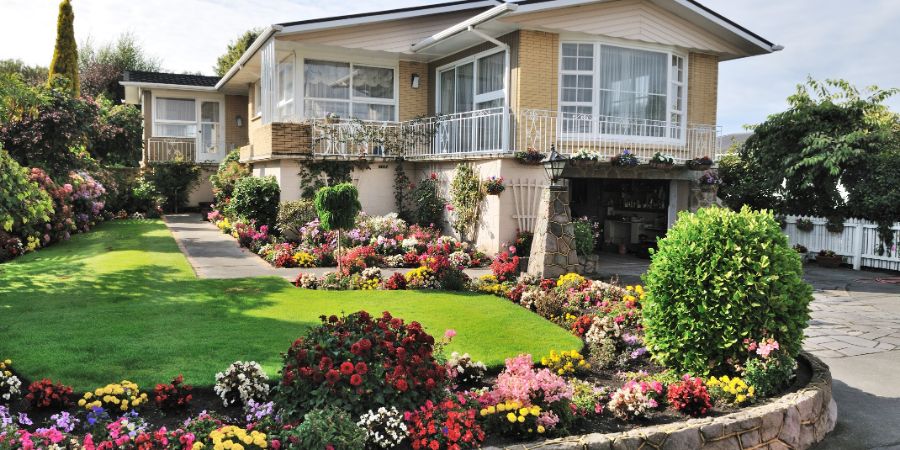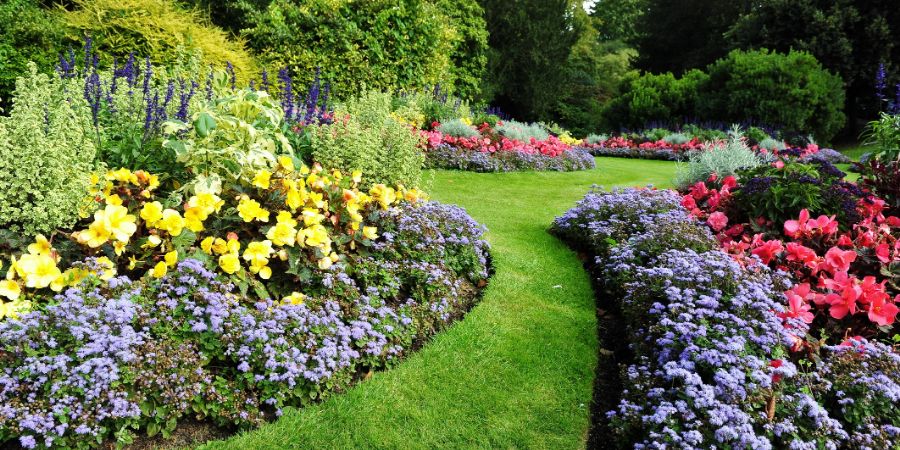Are you a certified landscape designer with an entrepreneurial spirit… But don’t know how to start a landscape design business of your very own? We’ve got you!
There are many things to consider when starting a business, and landscaping is no exception. In this article, we’re going to walk you through the ten steps you need to take in order to start a successful landscape design business from scratch. Plus, we’ll also answer some of the most common questions people have about starting their own landscaping company.
So, let’s get started!
Not yet a certified landscape designer? Discover how you can become one in as little as 12 short weeks!
How To Start a Landscape Design Business: 10 Steps For Success
So, where do you even begin? How should you get started?
Follow these simple steps and you’ll be well on your way!
Step #1: Determine Your Target Market
Before you can start marketing your services, you need to know who your target market is. Are you going to focus on residential clients? Commercial clients? Perhaps both?
Keep in mind that each type of clientele requires a different approach. For example, marketing to homeowners is going to be very different than marketing to a business owner or property manager.
Moreover, different types of businesses will also require different services. For instance, a homeowner might need help with their backyard. A commercial client, on the other hand, might need help with their office complex or a hotel they own.
One way or another, you absolutely NEED to know who your target market is before you can start advertising and promoting your business. Otherwise, you’ll be wasting time and money on marketing efforts that don’t reach the right people.
Once you know who your target market is, you can move on to the next step…
Step #2: Develop a Landscape Business Plan
Now that you know who your target market is, it’s time to start putting together your business plan. This document will outline your business goals, strategies, and how you plan on achieving them.
Your landscape business plan should include:
- An executive summary
- A company description
- A market analysis
- Your services and pricing structure
- Sales and marketing strategies
- An action/implementation plan
If you need help putting together your business plan, there are plenty of resources available online, like this one from the U.S. Small Business Administration. There are also tons of examples you can find online, too!

Step #3: Get Your Landscape Design Business Registered and Licensed
The next step is to get your business registered with the state and local government, as well as obtain any licenses or permits that may be required in your area.
This process will vary depending on where you live and what type of business you’re starting, but generally speaking, you’ll need to register your business name (also called a “doing business as” or DBA), get a tax ID number, and obtain a business license.
After this, next up is getting your business licensed. Now, as a landscape designer, you don’t technically need to have any sort of certification or licenses in order to work in this field (although some sort of professional training is strongly recommended if you want to actually be successful). That said, your business will probably need to be licensed.
Again, the licensing requirements will vary depending on your location, but you may need to obtain a general business license, a landscaping contractor’s license, and/or other permits before you can legally start operating.
Pro Tip: Check out QC Design School‘s self-paced, online Landscape Design Course and discover how YOU can become an International Landscape Design Professional (ILDP) in as little as 3 short months!
Step #4: Create Your Landscape Design Business Website
Nowadays, it’s absolutely essential to have an online presence if you want your business to be successful. And the best way to create an online presence is to have a website.
Your landscape design website should include:
- An eye-catching and easy-to-remember domain name (preferably .com)
- A clean and modern design that’s easy to navigate
- Pages about your company, services, pricing, FAQs, etc.
- A portfolio of your previous work
- Testimonials or reviews from happy clients
- Contact information (phone number, email address, and physical address)
- Social media links (Facebook, Twitter, Instagram, etc.)
Of course, you don’t need to be a web development expert to create a professional website these days. There are plenty of cheap – and even free – tools and resources available that make it easy to create a beautiful website, even if you have no prior experience. For example, WordPress is a popular content management system that’s used by millions of businesses around the world.
(Fun Fact: That’s actually what we use for our blog!)
Step #5: Get On Social Media
As we just mentioned, one of the most important things you can do for your landscape design business is to create a strong social media presence.
Not only will this help you reach more potential customers and grow your business, but it’s also a great way to show off your work, build trust and credibility, and connect with other professionals in your industry.
The best social media platforms for landscape designers are:
- TikTok
There are a few different ways you can go about setting up your social media accounts. You can do it yourself, hire someone to do it for you, or use a service like Hootsuite, Later, or Buffer to help you manage all your accounts in one place.
Once Your Accounts Are Set Up…
It’s time to start creating and sharing content. And when it comes to social media content, quality is far more important than quantity. Instead of trying to post as much as possible, focus on posting high-quality content that will actually be valuable or interesting to your target audience.
Some ideas for landscape design-related social media content include:
- Before and after photos
- Photos of your work in progress
- Landscape design tips and tutorials
- How-to videos
- Industry news and articles
- Infographics
- Case studies
- Testimonials or reviews from happy clients
- Photos/videos of you so your followers can put a face to your business
And don’t forget to include calls to action (CTAs) in your posts! For example, you could include a link to your website or portfolio in every post, or invite people to contact you for a free consultation.
Step #6: Promote/Market Your Landscape Design Business
Now that you have a website and social media accounts, it’s time to start promoting your business so you can start attracting clients.
There are a few different ways you can market your landscape design business, such as:
- SEO (Search Engine Optimization) – This is the process of optimizing your website and blog content to rank higher in search engine results pages (SERPs), which will help you attract more organic traffic (i.e. people who are searching for landscape design-related terms on Google, Bing, etc.).
- PPC Advertising (Pay-Per-Click) – This is a form of online advertising where you pay to have your ads displayed at the top of search engine results pages.
- Social Media Advertising – You can also use social media platforms like Facebook and Instagram to run paid ads.
- Content Marketing – This is a strategy where you create and share valuable content (e.g. blog posts, infographics, videos, etc.) in order to attract and engage your target audience.
- Email Marketing – You can also use email marketing to promote your business by sending Newsletters, special offers, or other types of email content to your subscribers.
There are a number of different marketing channels you can use to promote your business. Honestly, the best way to figure out which ones will work best for you is to experiment and test different tactics to see what gets results!

Step #7: Get Involved in Your Local Community
One of the best ways to market your landscape design business is to get involved in your local community. This is a great way to meet potential customers, build relationships, and make a positive impact in your area.
Some ideas for getting involved in your community include:
- Volunteering – You can volunteer with local organizations or non-profits that are related to landscape design, gardening, or the environment.
- Sponsoring – You can also sponsor local events or fundraisers that are related to your business.
- Hosting – You could host a workshop, seminar, or other event related to landscape design.
- Attending – Attend local networking events, trade shows, or conferences related to your industry.
- Joining – Join local business organizations or chambers of commerce.
The possibilities are endless! And the more involved you are in your community, the more likely people are to trust and recommend your business.
Step #8: Get Some Landscape Design Clients
One of the most important things you need to do if you want to start a successful landscape design business is, of course, to get clients! Here are a few ideas for how to do that:
- Reach out to your network – As we’ll discuss in the next step, networking is key in the landscape design industry. So, reach out to your friends, family, and acquaintances and let them know you’re starting a business. They may be able to refer you to someone they know who’s looking for a landscape designer.
- Cold-calling/emailing – You can also reach out to potential customers who you think might be interested in your services. This could include businesses, property management companies, or even individual homeowners.
- Advertising – As we mentioned before, there are a number of different ways you can advertise your business online and offline. So, make sure you’re utilizing all of the channels we mentioned earlier!
The most important thing is to just get started and get some clients under your belt. Once you have a few happy customers, it will be much easier to attract new business going forward.
Pro Tip: Here are 20 tried-and-true ways to find landscape design clients for your business!
Step #9: Start Networking
Another important thing you can do to grow your landscape design business is to start networking with other professionals in your industry. This is a great way to build relationships, learn from others, and get referrals.
Some ideas for how to network as a landscape designer include:
- Joining Professional Organizations – There are a number of different professional organizations you can join that are related to landscape design. These could include the American Society of Landscape Architects (ASLA), the Association of Professional Landscape Designers (APLD), or the International Society of Arboriculture (ISA).
- Attending Industry Events – You can also attend industry events, trade shows, or conferences related to landscape design. This is a great way to meet other professionals and learn about new trends in the industry.
- Connecting via Social Media – Social media is also a great way to connect with other landscape designers. You can follow industry leaders, join relevant groups, or even start your own group or blog.
- Taking Part In a Stylized Photoshoot – Stylized photoshoots involve working with a professional photographer to create beautiful images of your work. This is a great way to showcase your skills and collaborate with other experts in the design industry. As a result of your participation, you’ll likely receive high-quality photos that you can use for your website or portfolio. Plus, you may get client referrals from those you’re working with – or opportunities to collaborate together again someday for a paid project!
- Joining Online Communities – There are also a number of online communities you can join that are related to landscape design. These could include forums, Facebook groups, or LinkedIn groups. If you’re a student or graduate of QC Design School, for example, you can also join our free Virtual Classroom group on Facebook!
At the end of the day, the important thing is to just get started and get involved in the community. After all, the more you network, the more likely you are to grow your business!
Step #10: Keep Up With Industry Trends
Lastly, if you want to be successful as a landscape designer, it’s important to stay up-to-date with the latest industry trends. This way, you can ensure that your business is always ahead of the curve and offering the best possible services to your clients.
Some ways you can stay up-to-date with landscape design trends include:
- Reading Industry Publications – There are a number of different publications you can read that are related to landscape design. These could include magazines, blogs, or online articles.
- Attending Industry Events – As we mentioned before, attending industry events is a great way to stay up-to-date with the latest trends in landscape design. This way, you can learn about new products, services, and technologies that are being used in the industry.
- Following Industry Leaders on Social Media – Another great way to stay up-to-date with landscape design trends is to follow industry leaders on social media. This way, you can see what they’re doing and how they’re using new products or services in their business.
- Furthering Your Education/Adding To Your Design Qualifications – If you really want to stay ahead of the curve, you can always further your education or add to your design qualifications. This way, you’ll be able to offer even more services to your clients and stay up-to-date with all the latest trends in landscape design. Additionally, you can expand your business services by getting qualified in complementary areas of design, such as interior decorating, Feng Shui design, etc.!
Fun Fact: QC Design School offers a wide variety of online certification courses in different design fields. For example, we offer courses in Interior Decorating, Feng Shui Design, Home Staging, Professional Organizing, and more! Check out our full course list for more info!
Start a Business as a Landscape Designer: Answering Common FAQs
Now that you know how to start a landscape design business, let’s answer some common FAQs that you may have about starting your own business in general…

Q: How long does it take to become a landscape designer?
A: The amount of time it takes to become a landscape designer will vary depending on the path you take. If you choose to get a degree or certification in landscape design, for example, it could take anywhere from two to four years. However, if you choose to learn through an apprenticeship or online course, it could take less time.
If you were to train with QC Design School, for instance, your online Landscape Design Course would be entirely self-paced. So, even though you’d be given two years to complete it, you could use as much or as little of that time as needed. As a reference, many QC grads found that by devoting a mere 1-2 hours per week to their studies, they were able to graduate and earn their internationally-recognized certification in as little as 3 short months!
Q: How much does it cost to start a landscape design business?
A: The cost of starting a landscape design business can vary depending on a number of factors, such as the type of business you want to start, the services you plan on offering, the equipment you need, etc. However, you can expect to spend anywhere from a few hundred dollars to a few thousand dollars on start-up costs.
Business News Daily has an awesome article on the topic of small business startup costs that we highly recommend checking out!
Q: How much money can you make as a landscape designer?
A: The amount of money you can make as a landscape designer will depend on factors such as your experience level, the size of your clientele, the services you offer, etc. However, most landscape designers charge by the hour and earn an average of $50-$100 per hour.
Q: Is owning a landscaping company profitable?
A: Yes, owning a landscaping company can be quite profitable! In the United States alone, the market size of the landscaping industry is approx. $115.6 billion USD! In fact, the landscaping and gardening service market is expected to reach a CAGR (compound annual growth rate) of 4.2% between now and 2027.
Furthermore, it’s projected that by the year 2028, the landscaping services market will increase by a booming $85,370 million just in the U.S. alone!
Q: How can you start a landscaping business with no experience?
A: If you don’t have any experience in landscape design, that’s okay! There are a number of ways you can learn about the basics of landscape design and horticulture.
Some ways you can learn about landscape design include:
- Taking an online course (such as QC Design School’s Landscape Design Course!)
- Attending a landscape design workshop or seminar
- Shadowing/working with a more experienced landscape designer
Q: Can you start a landscaping business with no money?
A: While it is possible to start a landscape design business with little to no money, we recommend against it. This is because starting a business takes a lot of time, effort, and resources – all of which cost money.
Q: What are some landscaping business ideas?
A: Some landscape business ideas include starting a:
- Lawn care service
- Landscape design and build company
- Garden center
- Plant nursery
- Tree farm
- Sod farm
Q: What are some of the best landscape design software?
A: Some of the best landscape design software include:
Q: How much should you invest in startup costs for a landscape design business?
A: How much you should invest in startup costs for a landscape design business will depend on factors such as the size and scope of your business, the services you plan on offering, etc. However, most experts recommend investing at least $500-$10,000 in start-up costs.

Q: What are the ongoing expenses for a landscape design business?
A: The ongoing expenses for a landscape design business will vary depending on the size and scope of your business. However, some common ongoing expenses include:
- Advertising and marketing costs
- Salaries and wages (if you have employees)
- Insurance
- Rent or mortgage payments (if you have a brick-and-mortar location)
- Utilities
- Supplies and equipment
- Taxes
It’s hard to give a one-size-fits-all figure, in terms of how much ongoing expenses will cost you per year or per month. However, a very general estimate is that most small businesses spend between $500-$5,000 per month on ongoing expenses.
Q: How does a landscape design business make a profit?
A: A landscape design business makes a profit by charging clients for their services. How much you charge will depend on factors such as your experience level, the size of your clientele, the services you offer, etc. However, most landscape designers charge by the hour and earn an average of $50-$100 per hour, or by charging a flat rate fee for the entire project.
Q: How should you set your landscape design service rates (especially as a beginner)?
A: How you set your landscape design service rates will depend on a number of factors, such as your experience level, the size of your clientele, the services you offer, etc. That said, a good place to start is by researching the industry standard in your area – a.k.a. what your competitors are charging. Once you have a general idea of the going rate, you can then adjust your prices accordingly.
Q: Does your landscape design business need to be insured?
A: Yes, your landscape design business should be insured. After all, you’ll want to be covered in the event of any serious accidents, as they could potentially lead to lawsuits. Some common types of insurance for landscape businesses include general liability insurance, workers’ compensation insurance, and property damage insurance.
Q: Will you need a business license?
A: Most likely, yes – you will need a business license to operate your landscape design business. How to obtain a business license will vary depending on your location, but you can typically get one by visiting your local city or county clerk’s office.
Q: What do you need to know before registering your business/business name?
A: Before registering your business or business name, you’ll want to make sure that it’s available and that it complies with all the relevant laws in your area. To do this, you can conduct a search of your state’s business records and/or consult with an attorney.
There are a few ways to check and see if your business name is available, such as:
- Checking with your local chamber of commerce
- Searching your state’s business records
- Checking with the U.S. Patent and Trademark Office
- Consulting with an attorney
- Looking up web domain availability
- Checking on social media platforms
Q: How do you choose a business structure?
A: How you choose to structure your landscape design business will depend on a number of factors, such as the size and scope of your business, your personal preferences, etc. However, some common business structures for landscape businesses include sole proprietorships, partnerships, limited liability companies (LLCs), and corporations.
Q: How do you create a brand for your landscape design business?
A: Creating a brand for your landscape design business is important, as it will help you to attract and retain customers. How you go about branding your business will depend on a number of factors, such as your budget, target market, etc. However, some common branding strategies include creating a logo, developing a tagline or slogan, and using consistent colors and fonts across all your marketing materials.
Pro Tip: Learn everything you need to know about creating a strong, solid brand for your landscape design business!

Q: How do you register your business for taxes?
A: How you register your business for taxes will depend on a number of factors, such as the type of business you have, your location, etc. However, most businesses will need to register with the IRS and obtain a tax ID number. You may also need to file for state and local taxes, depending on where you’re located.
To get this all set up, you’ll want to:
- Determine what business taxes you’ll need to pay
- Register your business with the IRS
- Obtain a tax ID number for your business
- File for state and local taxes, if applicable
You can register your business with the IRS online, by mail, or by fax. To learn more, visit the IRS website. Next, to obtain a tax ID number for your business, you can apply for an Employer Identification Number (EIN) online, by mail, or by fax. You should also be able to find this info on the IRS’ website.
And lastly, the process for filing for state and local taxes will vary, depending on your location. To learn more, we recommend checking out your state’s tax website.
Q: How do you develop a marketing plan?
A: How you develop a marketing plan will depend on a number of factors, such as your budget, target market, etc. If you’re not sure how to get the ball rolling, here are some tips to get you started:
- Define your target market: Who are you trying to reach with your marketing?
- Set marketing goals: What do you hope to achieve with your marketing efforts?
- Create a budget: How much money are you willing to spend on marketing?
- Choose your marketing channels: How will you reach your target market? (Some common channels include print, online, and word-of-mouth.)
- Develop your marketing message: What are you trying to say with your marketing?
- Create a timeline: When will you launch your marketing campaign? How long will it run for?
Q: Should you open your own bank account and/or credit card for your landscape design business?
A: Yes, you should open your own bank account and/or credit card for your landscape design business. This will help you to keep track of your business expenses and income, and it will also help to build your business’ credit history. When choosing a bank or credit card company, be sure to compare features and fees so you can find the best option for your business.
Q: What are Net 30 accounts – and should you open one?
A: Net 30 accounts are lines of credit that businesses can use to purchase supplies and inventory. Typically, businesses have 30 days to pay off their balance before interest is charged. Whether or not you should open a Net 30 account will depend on a number of factors, such as your business’ cash flow, credit history, etc.
However, if you do decide to open a Net 30 account, be sure to shop around and compare terms and conditions so you can find the best deal for your business.
If this sounds like something of interest to you, check out these 9 best Net 30 accounts to help build business credit!
Q: What do you need to do in terms of accounting?
A: How you handle accounting for your landscape design business will depend on a number of factors, such as the size of your business, your location, etc. That said, most businesses will need to keep track of their income and expenses, and they’ll also need to file taxes on a regular basis.
To get started, we recommend reading up on basic accounting principles and/or hiring an accountant to help you out. You can also utilize affordable accounting software (if you’d rather handle this aspect of your business yourself), such as QuickBooks, FreshBooks, or Wave.
Q: How do you get started with bookkeeping?
A: Bookkeeping is essentially the process of tracking your business’ financial transactions. This can include income, expenses, invoices, payments, etc. How you handle bookkeeping for your landscape design business will depend on a number of factors, such as the size of your business, your location, etc.
If you’re not sure where to start, we recommend reading up on basic bookkeeping principles and/or hiring a bookkeeper to help you out. You can also utilize affordable bookkeeping software, if you’d rather handle this aspect of your business yourself).
Q: Will your landscape design business need any permits?
A: How to handle permits for your landscape design business will depend on a number of factors, such as your location, the type of work you’ll be doing, etc. However, in most cases, you will need to obtain at least one permit before you can start operating your business.
To find out what permits you’ll need for your business, we recommend checking with your local city or county office. They should be able to provide you with a list of the permits you’ll need, as well as any other information you might need.
Q: Should you develop a client contract?
A: Yes, you should develop a client contract for your landscape design business. This document will outline the terms of your agreement with your clients, and it will help to protect both you and them in the event that something goes wrong.
When creating your contract, be sure to include information such as the scope of work, payment terms, cancellation policy, etc. You can also use a contract template (such as this one from Rocket Lawyer) to help you get started.
Q: Should you require clients to sign a service agreement?
A: Yes, you should develop a client contract for your landscape design business. This document will outline the terms of your agreement with your clients, and it will help to protect both you and them in the event that something goes wrong.
When creating your contract, be sure to include information such as the scope of work, payment terms, cancellation policy, etc. You can also use a contract template (such as this one from Law Depot) to help you get started.

Q: Do you need to know the OSHA rules and regulations?
A: While you definitely do not need to know these by heart, it’s strongly recommended that all landscape designers – at the very least – reference the Occupational Safety and Health Administration’s rules and regulations for chemicals. This is because you will likely be working with (and around) chemicals on a regular basis, and you need to be aware of the risks involved.
You can find OSHA’s rules and regulations for chemicals on their website.
Q: What does a typical day for a landscape design business look like?
A: How your day-to-day operations will look will depend on a number of factors, such as the size and scope of your business, the type of work you do, etc. However, in general, most landscape design businesses will spend their days meeting with clients, designing landscapes, overseeing projects, and marketing their services.
Q: What skills do all landscape designers need?
A: As a landscape designer, you’ll need to have a strong understanding of horticulture, as well as basic design principles. Moreover, you should also be creative, detail-oriented, and able to work well with others.
Q: Should YOU build a professional landscape design business?
A: Only YOU can truly know if this is the right career path for you. However, here are some signs that you’re destined to start your very own landscape design business:
- You have a passion for horticulture and design!
- You’re creative, detail-oriented, and have a strong work ethic!
- You’re excited about the idea of owning your own business and being your own boss!
- You are not afraid of hard work!
- You possess strong communication skills!
- You’re looking for a career in a lucrative field, with lots of potential for growth, success, and profit!
Conclusion
So, there you have it: our complete guide on how to start a landscape design business in just ten simple steps. We hope this article has given you the information and inspiration you need to get started on your very own landscape design business journey!
If you have any questions about starting a landscape design business, or if you need help getting started, feel free to reach out to us. We would be more than happy to assist you in any way we can.
Thanks for reading! 🙂


